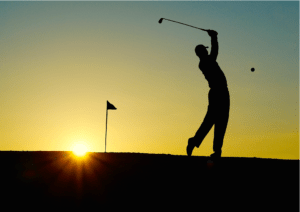Golf course outdoor workers are more concerned with avoiding stray golf balls than they are of protecting themselves from skin cancer, according to a new study.
 Recent research published in Occupational Medicine found that two thirds of Irish golf course workers were more concerned about work-place injuries than they were about sunburn or skin cancer.
Recent research published in Occupational Medicine found that two thirds of Irish golf course workers were more concerned about work-place injuries than they were about sunburn or skin cancer.
The study highlights the risk of sun exposure to golf course workers, this risk is shared by those working in similar jobs such as sport-ground and outdoor facility maintenance,
According to the research, only one in 10 golf course workers had received training on sun safety such as using sunscreen, sunglasses and protective clothing.
Skin cancer
The researchers also found that workers who had a good knowledge of skin cancer were more likely to use sunscreen.
“Failing to take appropriate measures to protect the skin from UV rays when working outdoors can have potentially life-threatening consequences later on,” said the British Skin Foundation’s Lisa Bickerstaffe.
“Employers of those that work outdoors could provide a uniform that includes sun protective clothing such as legionnaire style hats, long sleeves and sunglasses.
“They could also provide sunscreen and let workers stop for breaks when the UV rays are strongest (between 11am-3pm),” added Ms Bickerstaffe.
The research follows claims by the health and safety and employment agency Protecting.co.uk that insurance companies and private businesses are seeking to reduce the financial burden of golfing injuries by pushing for greater protection for players – including wearing hard hats or helmets.
Figures cited by the magazine Golf Monthly show that golf is statistically more dangerous than rugby, with seven in 10 amateur golfers suffering an injury whilst playing the game.
“If you look at a selection of other sports played in the UK, both contact and non-contact, there are measures in place to reduce injury,” said Protecting.co.uk spokesman, Chris Hall.
“For example, many amateur and lower-league rugby clubs insist on protective helmets; martial arts classes provide pads for their students – and this is not just to prevent injury. It’s because financially, it makes sense for clubs (and their insurers) to prove they’ve reduced harm wherever possible.”
“One particular case study which Protecting.co.uk cited is cycling. Cyclists in the UK are strongly encouraged to wear helmets to prevent injury – and a concerted effort to raise awareness of cycling safety has led to much greater uptake of protective gear.”
In August, SHP Online reported that a new website had been launched to help staff at golf clubs understand their responsibilities around health and safety.
The online platform contains information and guidance on all aspects of golf course management and maintenance, covering areas such as: roles and responsibilities; legislation; greenkeeping safety; events; clubhouse management; establishing a health and safety management system.
What makes us susceptible to burnout?
In this episode of the Safety & Health Podcast, ‘Burnout, stress and being human’, Heather Beach is joined by Stacy Thomson to discuss burnout, perfectionism and how to deal with burnout as an individual, as management and as an organisation.
We provide an insight on how to tackle burnout and why mental health is such a taboo subject, particularly in the workplace.

 Recent research published in Occupational Medicine found that two thirds of Irish golf course workers were more
Recent research published in Occupational Medicine found that two thirds of Irish golf course workers were more 